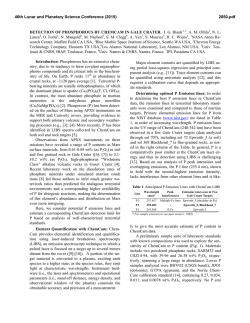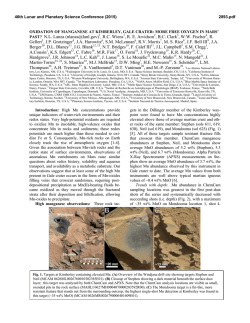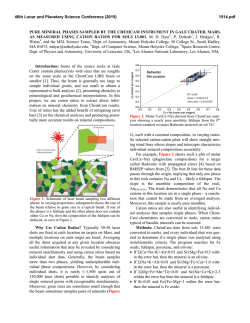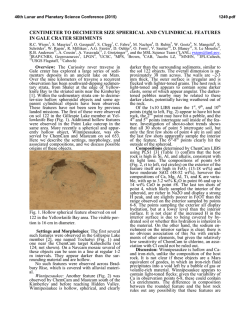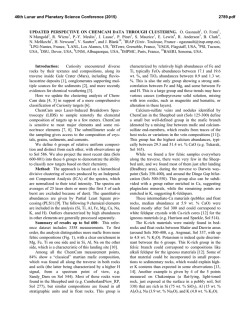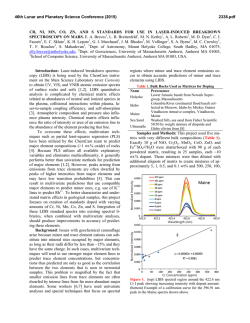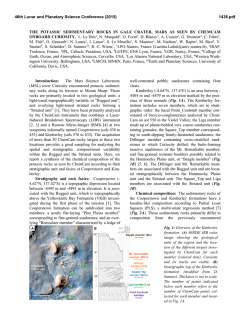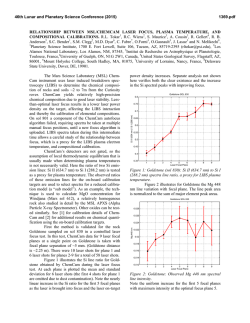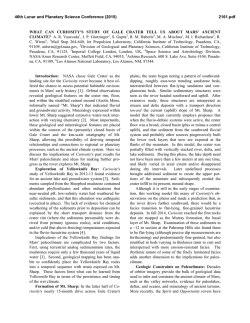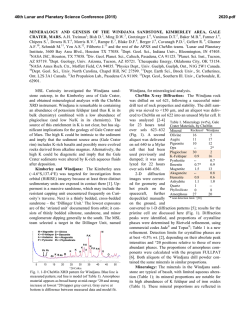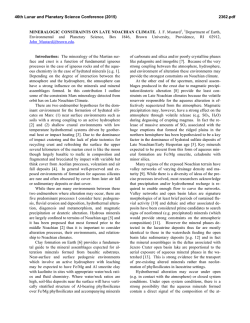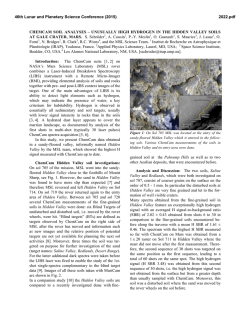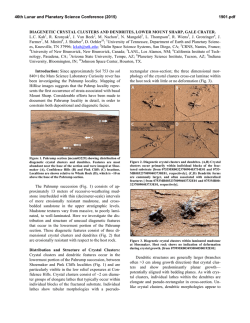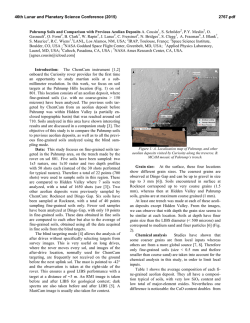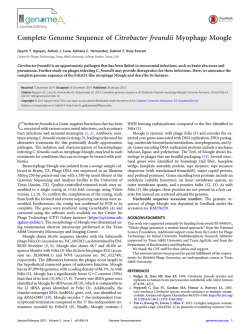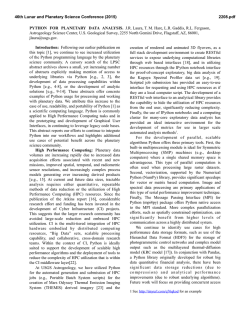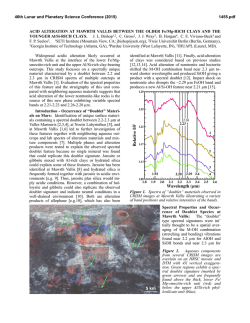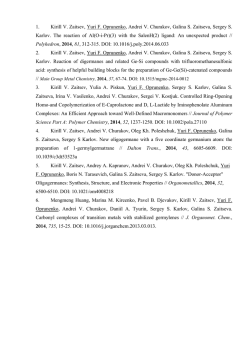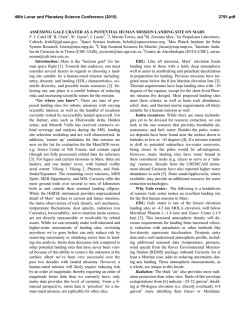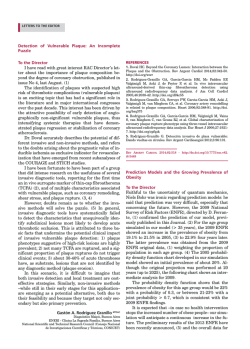
the diversity of sediments at gale crater from chemcam observations
46th Lunar and Planetary Science Conference (2015) 2093.pdf THE DIVERSITY OF SEDIMENTS AT GALE CRATER FROM CHEMCAM OBSERVATIONS: EVIDENCE FOR MULTIPLE SEDIMENT SOURCE CHEMISTRIES, DIVERSE ALTERATION HISTORIES, AND MULPTIPLE DIAGENETIC EPISODES. D. L. Blaney1 Roger Wiens2, Sylvestre Maurice3, Ryan Anderson4, John Bridges5, Sam Clegg2, Laetitia Le Deit6, Martin Fisk7 Olivier Forni3, Olivier Gasnault3, Linda Kah8, Nina Lanza2, Jeremie Lasue3, Nicholas Mangold6, Marion Nachon6, Horton Newsom9, Agnes Piller2, Violaine Sautter10, and the MSL Science Team.1NASA Jet Propulsion Laboratory, California Insituttue of Technology, 4800 Oak Grove Drive, MS 264-527, Pasadena, CA 91109 , 2Los Alamos National Laboratory, Los Alamos, NM 87544 USA,3 Université Paul Sabatier; UPS-OMP; Institute de Recherche en Astrophysique et Planetologie (IRAP), F-31400 Toulouse, France. CNRS; IRAP; 9 Av. Colonel Roche, BP 44346, F-31028 Toulouse cedex 4, France,.4U.S. Geological Survey, Astrogeology Science Center, Flagstaff, AZ 86001-1698, USA,5 Space Research Centre, Dept. of Physics & Astronomy, University of Leicester, LE1 7RH, UK, 6LPG Nantes, CNRS, UMR6112, Université Nantes, Nantes, France, 7College of Earth, Ocean, and Atmospheric Sciences, Oregon State University, Corvallis, OR 97331, 8University of Tennessee, Knoxville, TN 37996, SA, 9Institute of Meteoritics, University of New Mexico, Albuquerque, NM 87106, USA, 10Museum National d'Histoire Naturelle, Laboratoire de Minéralogie et Cosmochimie du Muséum, France. Summary: Since landing in Gale Crater the Curidata can be used to examine the compositional makeosity Rover has been investigating sedimentary materiup of lithified outcrops. Elemental variation within als using ChemCam. To date >5,400 separate chemical individual targets can then be used to infer mineralogy rock and soil measurements have been made, which by looking at elemental correlations. enable us to investigate the range of sediment chemistry along the traverse (Figure 1). Data reveals that the Gale sediments have multiple initial starting chemistries, and have experienced different alteration histories, including multiple episodes of diagenesis. Figure 1: Curiosity traverse showing key locations of ChemCam measurements. Data: ChemCam is a Laser Induced Breakdown Spectrometer (LIBS) with an integrated Remote Microscopic Imager (RMI) to provide context of where each LIBS spectra is collected. ChemCam LIBS works by firing a laser focused to a 350-550 µm diameter spot that produces plasma from the rock. Spectra of elemental emission lines are recorded from 240850 nm and used to determine the elemental composition of the rock [1,2, for more details on ChemCam and data analysis]. Chemical compositions were generated from individual spectra using the ChemCam team standard Partial Least Squares 1 analysis to produce elemental oxide abundance for SiO2 Fe2O3, CaO, MgO, Al2O3, TiO2, Na2O, and K2O [e.g. 3,4, 5]. These Figure 2. Key sedimentary unit compositions ratioed over conglomerate mean chemistry showing differences in sediment chemistry. Sediment Source Chemistry: Sediments and sedimentary rocks within Gale crater have three primary chemical source components (Figure 2). First is a basaltic component, which dominates the composition at locations such as Yellowknife Bay and Rocknest [6,7]. Second is a distinctly plagioclase feldspar-enriched composition, which is a contributor to coarser-grained facies at Darwin [8] and at Pahrump [9]. Third is a potassium feldspar-bearing component that is present in the Cooperstown and Kimberly outcrops [10]. Basalt-dominated compositions are present in both mudstones at Yellow Knife Bay [6,11] and in sandstones [7, 12]. The differences in chemistry may be the result of: 1) different source regions for the sediments either originating from different physical locations or sampling deeper units in the crust as deposition continued; 2) differences in transport / sorting during deposition; or 3) a combination a source region variability and transport. However since the sandstones have indications of all three-source components the differences in chemistry is not primarily due to grain size effects and some change in the source chemistry is likely. 46th Lunar and Planetary Science Conference (2015) Degree of Alteration: The sediments at Gale range from having strong preservation of primary igneous components, to having substantial contribution from secondary alteration minerals. CheMin observations at Yellowknife Bay show large amounts of amorphous material and smectitie clays [13] while the Kimberly outcrop is much less altered [14]. At locations where there is no CheMin mineralogical data, ChemCam can be used to assess the amount of alteration via a combination of sedimentary texture and elemental patterns that can be used to infer mineralogy. In conglomerates such as those at Darwin, pebbles frequently have igneous textures [13] and ChemCam patterns support a plagioclase phase being present [8]. At Rocknest, Fe and Mg patterns suggest both the presence of iron oxides and depletion of primary olivine materials [7]. These data indicate that, while likely not as altered as the Yellowknife Bay mudstones, some chemical alteration had taken place in the formation. At Pahrump, different elemental patterns are seen in the Al2O3-TiO2-FeOT-SiO2 (Figure 3) in the adjacent Book Cliff and Pink Cliff regions suggesting that although the overall chemistry of the outcrop is similar for both facies [7,14], the Pink Cliff (lower) part of the outcrop is much more altered. Figure 3. Elemental relationships between Al2O3 and TiO2, FeOT, and SiO2 in the Book Cliffs Region (top, target Goblin Valley) and in Pink Cliffs region (bottom, targets Delta (no vein), San Rafael Swell (no rim around crack), Castle Valley, Ibex Pass (no vein), Saddle Peak). The correlation of Al2O3 with TiO2 and lack of correlation with SiO2 suggest that altered mineral phases are present at Pink Cliffs. This contrasts with the Book Cliffs region observation where positive Al2O3 with SiO2 suggest plagioclase feldspar is present. 2093.pdf Diagenetic Features: There is also evidence for widespread and variable diagenetic processes. Post deposition aqueous activity at Gale continued to be widespread with variable chemistry including fluids rich in calcium and magnesium sulfate, Mn-oxides, and fluorine. Calcium Sulfate Calcium sulfate veins have been observed in all of the sandstones / mudstones observed by ChemCam at Gale [e.g. 6, 7, 8, 9, 10, 15]. These veins fill fractures that cross cut the sandstones and are likely the most recent aqueous event in the area. Mg Loss and Mg Enhancements: Raised Mg-rich ridges are seen at Yellowknife Bay and Pahrump by ChemCam [16] and at Pahrump APXS determined that the were also enriched in S, N, Cl, and Br suggesting that they were caused by the emplacement of MgSO4 rich fluids [17]. Sediments depleted in MgO have also been observed, most notably at Rocknest [7] suggesting that diagenetic alteration of olivine may be a source for the Mg [7, 16]. MnO Coatings/Resistant Ridges: At Kimberly, MnO coatings and resistant ridges indicate the presence of a highly oxidizing fluid [18]. Enhanced MnO is spatially restricted and is one of the most localized diagenetic features. CaF: CaF has been detected in various locations, including Pahrump concentrated in resistant ridges, indicating a fluvial origin for the phase [9,19]. References: [1]Wiens et al. 2013 . Spa. Sci. Rev. 170, 167-227. [2] Maurice et al. Space Science Reviews, 170:95-166, doi:10.1007/s11214-012-9912-2. [3] Wiens 2013 Spectrochimica Acta Part B: Atomic Spectroscopy 82, 1-27. [4] Clegg et al., 2009 Spectrochim. Acta Part B 64, 79–88, [5] Anderson 2012 Spa. Sci. Rev. 170, 57-75. [6] McLennan et al. 2013, Science, doi:10.1126/science.1244734. [7] Blaney et al. 2014, Journal of Geophysical Research Planets, 119 (9):2109-2131, doi:10.1002/2013JE004590, 2014. [8] Mangold et al. 2014 Fall AGU. [9] Forni et al 2015, LPSC This volume. [10] Le Deit et al 2015, LPSC This volume. [11] Grotzinger 2013, Science, doi:10.1126/science.1242777. [12] Schmidt et al. 2014 Journal of Geophysical Research Planets, 119(1):6481, doi:10.1002/2013JE004481. [13] Sattuer et al. 2014 Journal of Geophysical Research Planets, 119(1): 30-46, doi:10.1002/2013JE004472. [14] Milliken et al. 2015 LPSC This volume [15] Nachon et al, 2014 Journal of Geophysical Research Planets, 119(9):1991-2016, doi:10.1002/2013JE004588. [15] Levaile et al. 2014 , Journal of Geophysical Research Planets, 119, doi: 10.1002/ 2014JE004620. [16] Thompson et al 2015 LPSC This volume. [18] Lanza et al 2015 LPSC This Volume [19] Forni et al. 2014, LPSC.
© Copyright 2025
